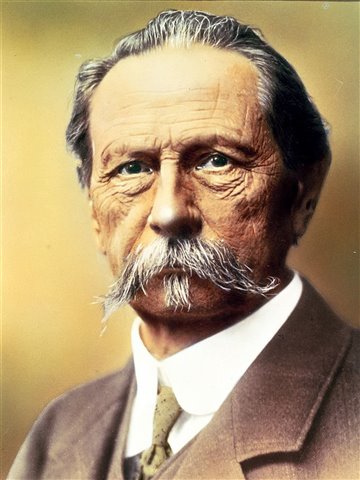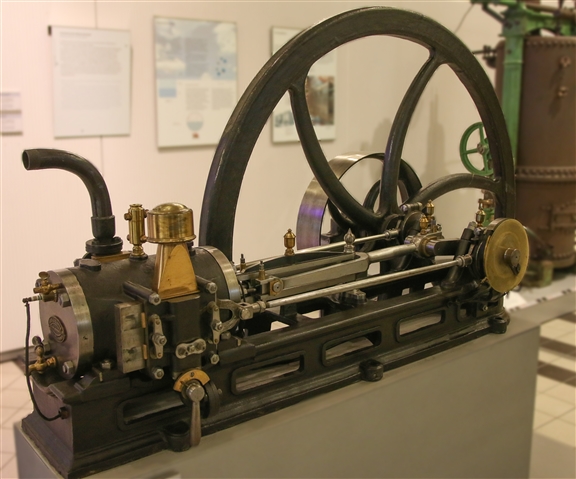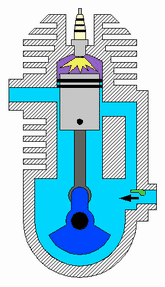On This Day in (Engineering) History
December 31, 1878 - Karl Benz patents the first reliable two-stroke petrol engine
Few things scream 'the twentieth century' like an open-top car whizzing along a straight, open road, wind through the hair, music on the radio. Or maybe a car containing a man in a hat and trench coat, driving through the dark on a rain-swept night. Perhaps a car full of guys bouncing their heads to the heavy guitar of Queen's Bohemian Rhapsody.
What does this have to do with Karl Benz?
Everything.
Induction
 Karl Friedrich Michael Vaillant was born in 1844 - in Mühlburg, now a borough of Karlsruhe, in the German state of Baden-Württemberg – to unmarried parents. Karl's parents had married before he was two years old, but this stability didn't last. When Karl was two, his father died of pneumonia or in a railway accident, depending on the source, and he was renamed 'Benz' in honour of his father.
Karl Friedrich Michael Vaillant was born in 1844 - in Mühlburg, now a borough of Karlsruhe, in the German state of Baden-Württemberg – to unmarried parents. Karl's parents had married before he was two years old, but this stability didn't last. When Karl was two, his father died of pneumonia or in a railway accident, depending on the source, and he was renamed 'Benz' in honour of his father.
Despite being mired in poverty, Karl's mother made every effort to put him through a solid education, and he was an exceptional student. He went to his local grammar school before joining a more scientifically oriented school at the age of nine. Initially, he took to locksmithing before moving into locomotives. At 15, he joined the Poly-Technical University in Karlsruhe after passing the mechanical engineering entrance exam. In 1864, Karl graduated aged 19.
His early career stuttered, with short-term positions at different engineering firms, including a bridge builder (based in Pforzheim, where he met his future wife, Bertha Ringer), a manufacturer of scales and an iron construction company. In 1871, he joined up with the chronically unreliable August Ritter to form a mechanical workshop and materials supplier based in Mannheim. After a disastrous first year, the local authorities confiscated the business, and Karl's fiancé, Bertha Ringer, used her dowry to buy out Ritter's share of the company. The following year, they married, later having five children.
Karl Benz in later life. Source: Wikimedia Commons
Compression
By the late 19th century, the idea of using an engine to do work was well established. The type of engine used at the time was the problem. The main issue for steam engines is the need to burn fuel in a furnace outside of the engine, away from the pistons. It makes the engine bulky and heavy, giving it low thermal efficiency.
Experiments trialling hot gasses to drive pumps had been going on since the 17th century. At the end of that century, Franco-British physicist Denis Papin (developer of the pressure cooker's forerunner) published a steam engine design. In 1707, Thomas Newcomen picked it up and built it for real. Attempts to develop an internal combustion engine continued in Britain, the US and France throughout the 18th and 19th centuries. Figures such as Christian Huygens, Alessandra Volta, John Barber, Robert Street, and François Isaac de Rivaz all worked on internal combustion engines which mixed air with a fuel substance (such as hydrogen, petroleum, and dust) inside a chamber before igniting it with pressure or an electrical spark.
 By 1864, one of these pioneers, French engineer Etienne Lenoir, had designed, built and begun to sell engines based on the idea of burning a coal gas/air mixture by jumping a spark through the gaseous mix held within a chamber. While this did work, and the resulting engine was sold commercially, it was still profoundly inefficient, using only 4% of the energy input to create an output. In 1824, French military officer and engineer Sadi Carnot published 'Reflections on the Motive Power of Fire,' where he concerned himself with the theoretical model of thermodynamics rather than the mechanical aspect.
By 1864, one of these pioneers, French engineer Etienne Lenoir, had designed, built and begun to sell engines based on the idea of burning a coal gas/air mixture by jumping a spark through the gaseous mix held within a chamber. While this did work, and the resulting engine was sold commercially, it was still profoundly inefficient, using only 4% of the energy input to create an output. In 1824, French military officer and engineer Sadi Carnot published 'Reflections on the Motive Power of Fire,' where he concerned himself with the theoretical model of thermodynamics rather than the mechanical aspect.
By 1861, another French engineer and scientist, Alphonse Beau de Rochas, produced the main theoretical breakthrough when he described the necessary conditions for a four-stroke internal combustion engine. German engineer Nikolaus Otto built an engine based on these principles in 1876. Amongst all this, it is easy to overlook yet another French engineer, Philippe LeBon D'Humberstein, who, in 1801, put forward the idea of a two-stroke gas engine.
Lenior Gas Motor Source: Wikimedia Commons
Power
Karl realised that he could bring in revenue by patenting his inventions. As his luck would have it, Nikolaus Otto had designed a four-stroke engine. Bad luck for Nikolaus; his patent had been voided by a procedural error (his, but who knows?). Karl based his two-stroke design on Otto's four-stroke. Even so, Karl believed the future in powered machinery and automobiles would be in the two-stroke engine, something he pushed his company to focus on. Besides, after Deutz Gasmotorenfabrik won a patent for a four-stroke engine, perhaps Karl felt that door had closed.
______________________________________________________________________________________________________________________________________
A four-stroke petrol engine works in four stages – induction (where the air/fuel mixture is sucked into the combustion chamber by the descending piston), compression (the rising piston compresses the mixture), power (a spark from the spark plug ignites the compressed mixture, forcing the piston downward) and exhaust (the rising piston forces the exhaust gases out of the chamber).
______________________________________________________________________________________________________________________________________
 In 1878, he patented a water radiator, clutch and gear change mechanism, battery, spark plug, electrical ignition system, and carburettor. On December 31, 1879, Karl patented his two-stroke gas engine. It used a simple, compact, and efficient design, producing a greater power output than was expected for such a small engine. With fewer moving parts than contemporary four-stroke engines, it featured less friction than rival power plants.
In 1878, he patented a water radiator, clutch and gear change mechanism, battery, spark plug, electrical ignition system, and carburettor. On December 31, 1879, Karl patented his two-stroke gas engine. It used a simple, compact, and efficient design, producing a greater power output than was expected for such a small engine. With fewer moving parts than contemporary four-stroke engines, it featured less friction than rival power plants.
1984 Mercedes-Benz 280 E saloon/station wagon. Source: Wikimedia Commons
______________________________________________________________________________________________________________________________________
Two-stroke petrol engines use two movements of the piston.
Compression: the upward-moving piston pulls a mix of oil, petrol, and air into the crankcase through the intake valve. While that happens, the rising piston is compressing a fuel, oil, and air mixture into a small combustion chamber at the head of the cylinder.
Power: The spark plug explodes the fuel mixture, forcing the piston downward, closing the intake valve and sucking the fuel, air, and oil mixture from the crankcase into the combustion chamber through a transfer port. As this happens, waste gases from the explosion are forced through the exhaust valve.
A two-stroke engine. Source: Wikimedia Commons
_______________________________________________________________________________________________________________
Exhaust
While the mechanisms Karl developed to make the motorcar possible have assured his legacy, the two-stroke petrol engine would never be more than a niche option in car manufacturing. Instead, it would flourish when used to drive power tools, such as lawnmowers and chainsaws, and transport such as motorcycles, tuk-tuks, and outboard motor engines.
His financial backers were unhappy at the thought of a capital-intensive operation held in private hands. Perhaps to spread the risk, they insisted on Karl forming a joint stock company, Gasmotoren Fabrik Mannheim, with a photographer and his brother in 1882. Left with only 5% of the shares, Karl became disgruntled and left a year later, in 1883.
Saab 96 Sport, powered by a two-stroke engine,1966. Source: Wikimedia Commons

Two years later, he built and demonstrated the very first practical motorcar. In 1888, Bertha and two of their sons would take (without Karl's knowledge) a Benz Patent-Motorwagen No. 3 on a 60-mile (106 km) round trip to her family in Pforzheim, becoming the first motorist.
The rest, for good and bad, is the twentieth and twenty-first centuries.
------------------------------------------------
What do you say?
The internal combustion engine could be said to be inefficient (by modern standards), Victorian technology. Why has it taken so long to find a replacement?